Health Statistics Assignment: Article Analysis and Ethics Review
VerifiedAdded on 2023/03/23
|6
|1326
|38
Report
AI Summary
This report provides a comprehensive analysis of a quantitative research article focusing on the preparedness of Omani novice nurse educators. The study, published in the International Journal of Nursing Education, investigated the competencies of novice nurse educators using a descriptive quantitative design. The analysis examines the problem and purpose statements, research questions, and the application of Benner’s model. It identifies the dependent and independent variables, population, sample, and data collection methods, including the use of a Nursing Education Competence Inventory questionnaire. The report summarizes the data analysis process, results, and limitations of the study, which found five major competencies predictive of preparedness. Furthermore, it evaluates the ethical considerations, including informed consent, anonymity, and data storage, while also pointing out potential ethical issues and limitations not explicitly addressed in the original article. The analysis highlights the importance of transparency and ethical conduct in healthcare research.
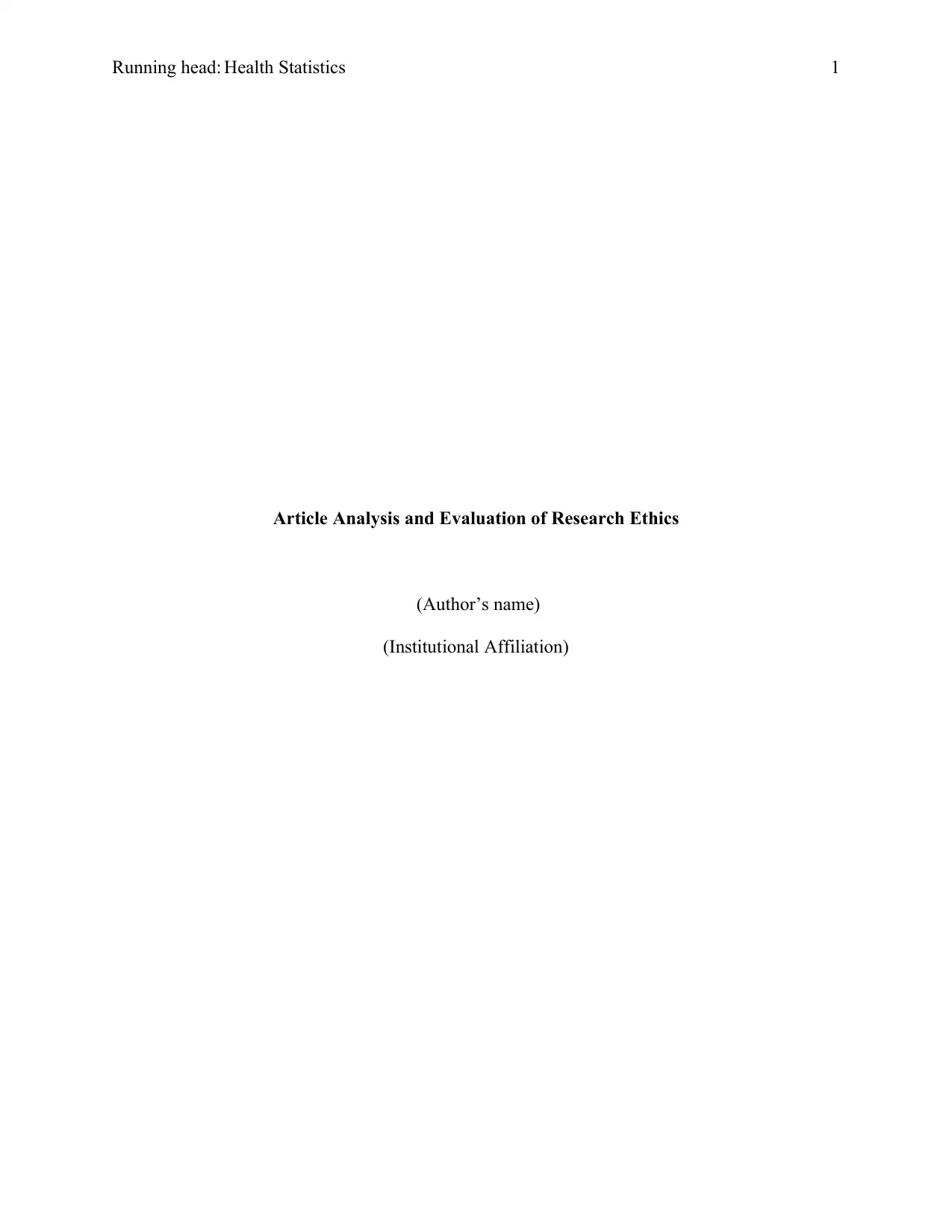
Running head: Health Statistics 1
Article Analysis and Evaluation of Research Ethics
(Author’s name)
(Institutional Affiliation)
Article Analysis and Evaluation of Research Ethics
(Author’s name)
(Institutional Affiliation)
Paraphrase This Document
Need a fresh take? Get an instant paraphrase of this document with our AI Paraphraser
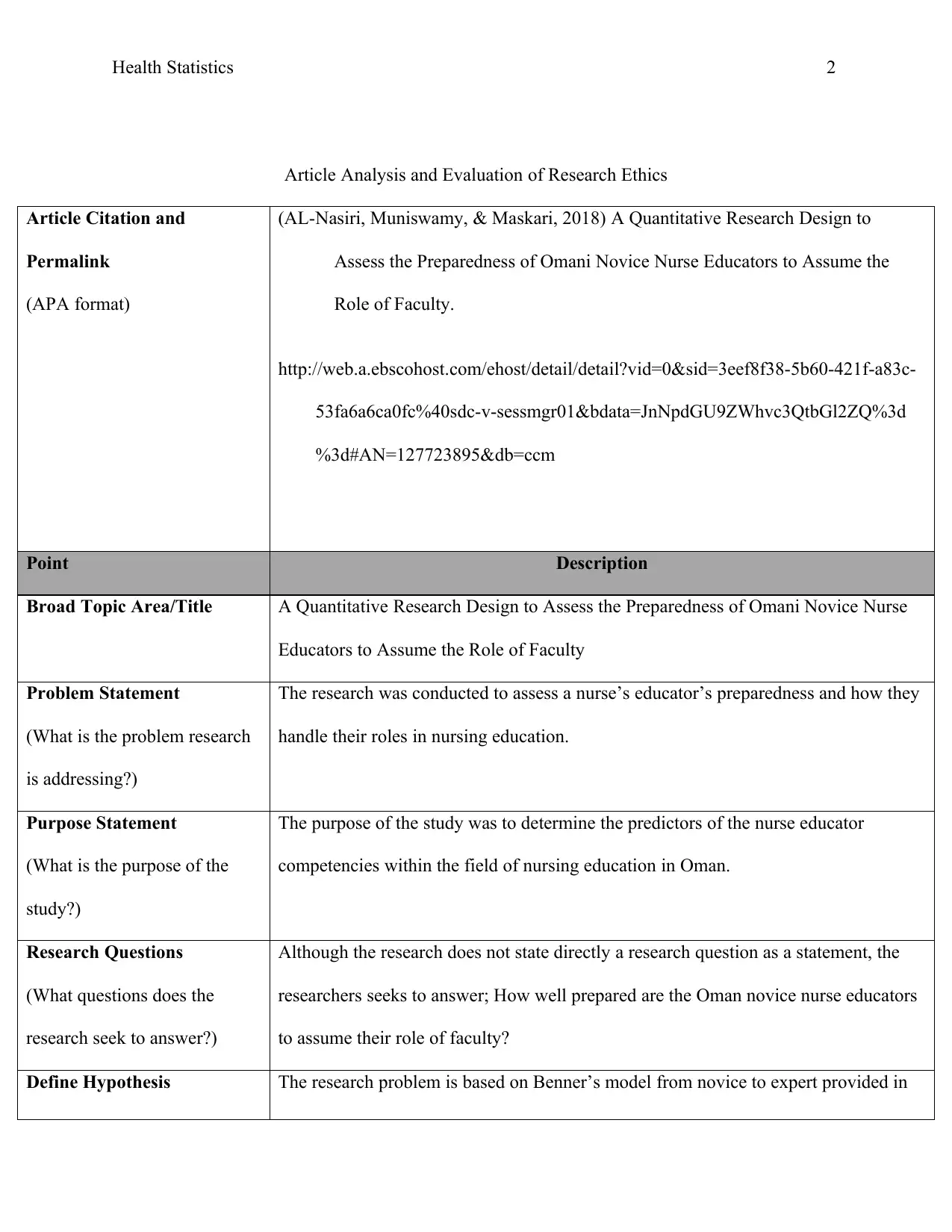
Health Statistics 2
Article Analysis and Evaluation of Research Ethics
Article Citation and
Permalink
(APA format)
(AL-Nasiri, Muniswamy, & Maskari, 2018) A Quantitative Research Design to
Assess the Preparedness of Omani Novice Nurse Educators to Assume the
Role of Faculty.
http://web.a.ebscohost.com/ehost/detail/detail?vid=0&sid=3eef8f38-5b60-421f-a83c-
53fa6a6ca0fc%40sdc-v-sessmgr01&bdata=JnNpdGU9ZWhvc3QtbGl2ZQ%3d
%3d#AN=127723895&db=ccm
Point Description
Broad Topic Area/Title A Quantitative Research Design to Assess the Preparedness of Omani Novice Nurse
Educators to Assume the Role of Faculty
Problem Statement
(What is the problem research
is addressing?)
The research was conducted to assess a nurse’s educator’s preparedness and how they
handle their roles in nursing education.
Purpose Statement
(What is the purpose of the
study?)
The purpose of the study was to determine the predictors of the nurse educator
competencies within the field of nursing education in Oman.
Research Questions
(What questions does the
research seek to answer?)
Although the research does not state directly a research question as a statement, the
researchers seeks to answer; How well prepared are the Oman novice nurse educators
to assume their role of faculty?
Define Hypothesis The research problem is based on Benner’s model from novice to expert provided in
Article Analysis and Evaluation of Research Ethics
Article Citation and
Permalink
(APA format)
(AL-Nasiri, Muniswamy, & Maskari, 2018) A Quantitative Research Design to
Assess the Preparedness of Omani Novice Nurse Educators to Assume the
Role of Faculty.
http://web.a.ebscohost.com/ehost/detail/detail?vid=0&sid=3eef8f38-5b60-421f-a83c-
53fa6a6ca0fc%40sdc-v-sessmgr01&bdata=JnNpdGU9ZWhvc3QtbGl2ZQ%3d
%3d#AN=127723895&db=ccm
Point Description
Broad Topic Area/Title A Quantitative Research Design to Assess the Preparedness of Omani Novice Nurse
Educators to Assume the Role of Faculty
Problem Statement
(What is the problem research
is addressing?)
The research was conducted to assess a nurse’s educator’s preparedness and how they
handle their roles in nursing education.
Purpose Statement
(What is the purpose of the
study?)
The purpose of the study was to determine the predictors of the nurse educator
competencies within the field of nursing education in Oman.
Research Questions
(What questions does the
research seek to answer?)
Although the research does not state directly a research question as a statement, the
researchers seeks to answer; How well prepared are the Oman novice nurse educators
to assume their role of faculty?
Define Hypothesis The research problem is based on Benner’s model from novice to expert provided in
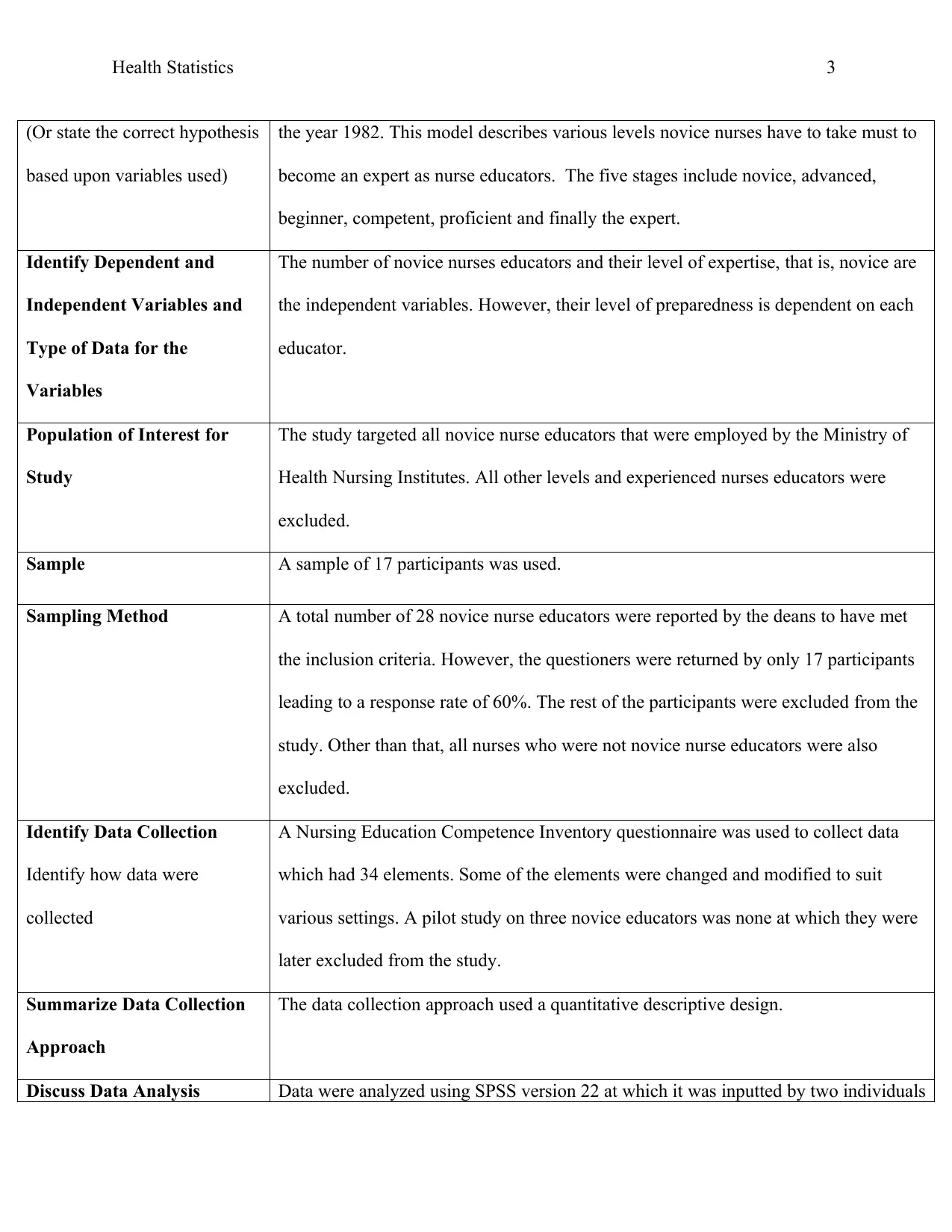
Health Statistics 3
(Or state the correct hypothesis
based upon variables used)
the year 1982. This model describes various levels novice nurses have to take must to
become an expert as nurse educators. The five stages include novice, advanced,
beginner, competent, proficient and finally the expert.
Identify Dependent and
Independent Variables and
Type of Data for the
Variables
The number of novice nurses educators and their level of expertise, that is, novice are
the independent variables. However, their level of preparedness is dependent on each
educator.
Population of Interest for
Study
The study targeted all novice nurse educators that were employed by the Ministry of
Health Nursing Institutes. All other levels and experienced nurses educators were
excluded.
Sample A sample of 17 participants was used.
Sampling Method A total number of 28 novice nurse educators were reported by the deans to have met
the inclusion criteria. However, the questioners were returned by only 17 participants
leading to a response rate of 60%. The rest of the participants were excluded from the
study. Other than that, all nurses who were not novice nurse educators were also
excluded.
Identify Data Collection
Identify how data were
collected
A Nursing Education Competence Inventory questionnaire was used to collect data
which had 34 elements. Some of the elements were changed and modified to suit
various settings. A pilot study on three novice educators was none at which they were
later excluded from the study.
Summarize Data Collection
Approach
The data collection approach used a quantitative descriptive design.
Discuss Data Analysis Data were analyzed using SPSS version 22 at which it was inputted by two individuals
(Or state the correct hypothesis
based upon variables used)
the year 1982. This model describes various levels novice nurses have to take must to
become an expert as nurse educators. The five stages include novice, advanced,
beginner, competent, proficient and finally the expert.
Identify Dependent and
Independent Variables and
Type of Data for the
Variables
The number of novice nurses educators and their level of expertise, that is, novice are
the independent variables. However, their level of preparedness is dependent on each
educator.
Population of Interest for
Study
The study targeted all novice nurse educators that were employed by the Ministry of
Health Nursing Institutes. All other levels and experienced nurses educators were
excluded.
Sample A sample of 17 participants was used.
Sampling Method A total number of 28 novice nurse educators were reported by the deans to have met
the inclusion criteria. However, the questioners were returned by only 17 participants
leading to a response rate of 60%. The rest of the participants were excluded from the
study. Other than that, all nurses who were not novice nurse educators were also
excluded.
Identify Data Collection
Identify how data were
collected
A Nursing Education Competence Inventory questionnaire was used to collect data
which had 34 elements. Some of the elements were changed and modified to suit
various settings. A pilot study on three novice educators was none at which they were
later excluded from the study.
Summarize Data Collection
Approach
The data collection approach used a quantitative descriptive design.
Discuss Data Analysis Data were analyzed using SPSS version 22 at which it was inputted by two individuals
⊘ This is a preview!⊘
Do you want full access?
Subscribe today to unlock all pages.

Trusted by 1+ million students worldwide
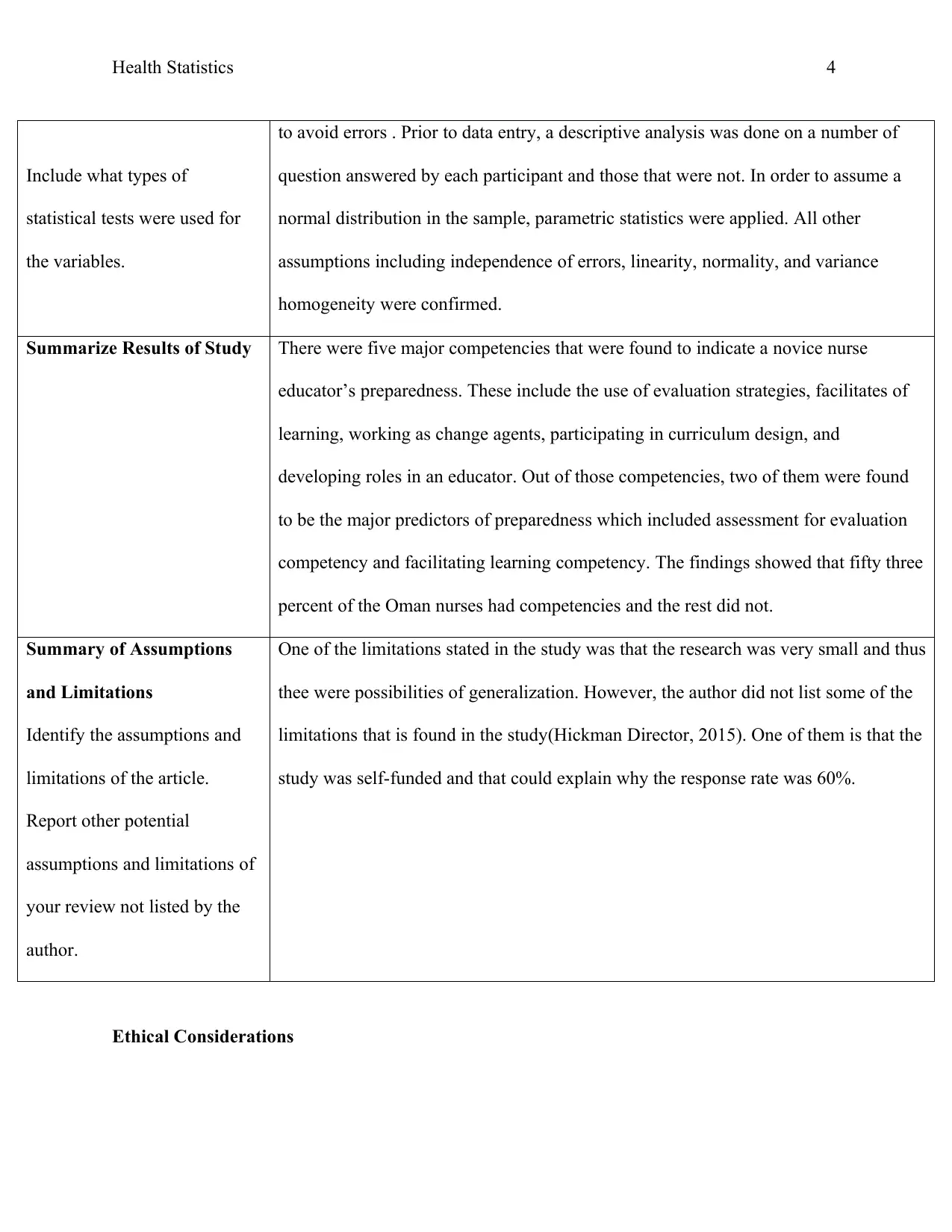
Health Statistics 4
Include what types of
statistical tests were used for
the variables.
to avoid errors . Prior to data entry, a descriptive analysis was done on a number of
question answered by each participant and those that were not. In order to assume a
normal distribution in the sample, parametric statistics were applied. All other
assumptions including independence of errors, linearity, normality, and variance
homogeneity were confirmed.
Summarize Results of Study There were five major competencies that were found to indicate a novice nurse
educator’s preparedness. These include the use of evaluation strategies, facilitates of
learning, working as change agents, participating in curriculum design, and
developing roles in an educator. Out of those competencies, two of them were found
to be the major predictors of preparedness which included assessment for evaluation
competency and facilitating learning competency. The findings showed that fifty three
percent of the Oman nurses had competencies and the rest did not.
Summary of Assumptions
and Limitations
Identify the assumptions and
limitations of the article.
Report other potential
assumptions and limitations of
your review not listed by the
author.
One of the limitations stated in the study was that the research was very small and thus
thee were possibilities of generalization. However, the author did not list some of the
limitations that is found in the study(Hickman Director, 2015). One of them is that the
study was self-funded and that could explain why the response rate was 60%.
Ethical Considerations
Include what types of
statistical tests were used for
the variables.
to avoid errors . Prior to data entry, a descriptive analysis was done on a number of
question answered by each participant and those that were not. In order to assume a
normal distribution in the sample, parametric statistics were applied. All other
assumptions including independence of errors, linearity, normality, and variance
homogeneity were confirmed.
Summarize Results of Study There were five major competencies that were found to indicate a novice nurse
educator’s preparedness. These include the use of evaluation strategies, facilitates of
learning, working as change agents, participating in curriculum design, and
developing roles in an educator. Out of those competencies, two of them were found
to be the major predictors of preparedness which included assessment for evaluation
competency and facilitating learning competency. The findings showed that fifty three
percent of the Oman nurses had competencies and the rest did not.
Summary of Assumptions
and Limitations
Identify the assumptions and
limitations of the article.
Report other potential
assumptions and limitations of
your review not listed by the
author.
One of the limitations stated in the study was that the research was very small and thus
thee were possibilities of generalization. However, the author did not list some of the
limitations that is found in the study(Hickman Director, 2015). One of them is that the
study was self-funded and that could explain why the response rate was 60%.
Ethical Considerations
Paraphrase This Document
Need a fresh take? Get an instant paraphrase of this document with our AI Paraphraser
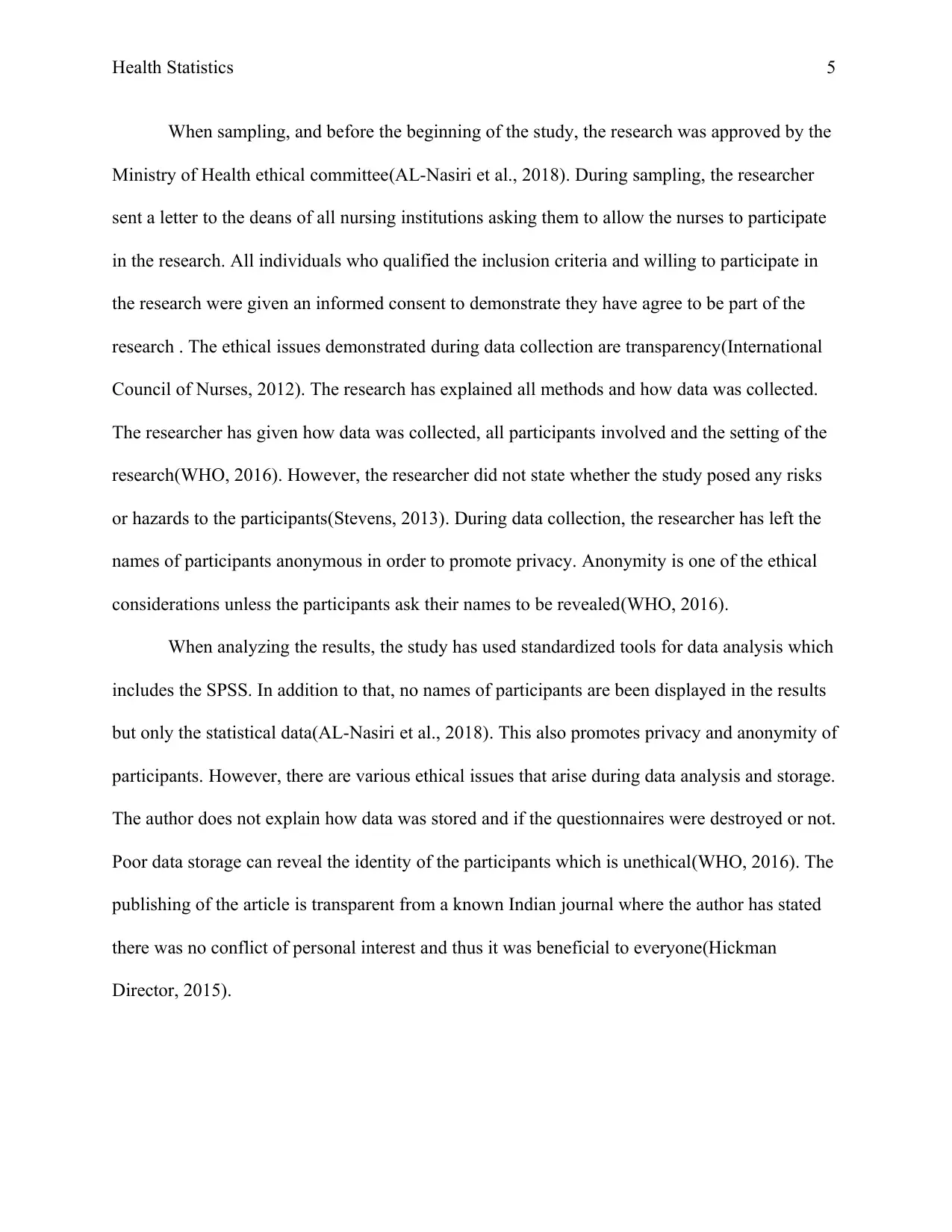
Health Statistics 5
When sampling, and before the beginning of the study, the research was approved by the
Ministry of Health ethical committee(AL-Nasiri et al., 2018). During sampling, the researcher
sent a letter to the deans of all nursing institutions asking them to allow the nurses to participate
in the research. All individuals who qualified the inclusion criteria and willing to participate in
the research were given an informed consent to demonstrate they have agree to be part of the
research . The ethical issues demonstrated during data collection are transparency(International
Council of Nurses, 2012). The research has explained all methods and how data was collected.
The researcher has given how data was collected, all participants involved and the setting of the
research(WHO, 2016). However, the researcher did not state whether the study posed any risks
or hazards to the participants(Stevens, 2013). During data collection, the researcher has left the
names of participants anonymous in order to promote privacy. Anonymity is one of the ethical
considerations unless the participants ask their names to be revealed(WHO, 2016).
When analyzing the results, the study has used standardized tools for data analysis which
includes the SPSS. In addition to that, no names of participants are been displayed in the results
but only the statistical data(AL-Nasiri et al., 2018). This also promotes privacy and anonymity of
participants. However, there are various ethical issues that arise during data analysis and storage.
The author does not explain how data was stored and if the questionnaires were destroyed or not.
Poor data storage can reveal the identity of the participants which is unethical(WHO, 2016). The
publishing of the article is transparent from a known Indian journal where the author has stated
there was no conflict of personal interest and thus it was beneficial to everyone(Hickman
Director, 2015).
When sampling, and before the beginning of the study, the research was approved by the
Ministry of Health ethical committee(AL-Nasiri et al., 2018). During sampling, the researcher
sent a letter to the deans of all nursing institutions asking them to allow the nurses to participate
in the research. All individuals who qualified the inclusion criteria and willing to participate in
the research were given an informed consent to demonstrate they have agree to be part of the
research . The ethical issues demonstrated during data collection are transparency(International
Council of Nurses, 2012). The research has explained all methods and how data was collected.
The researcher has given how data was collected, all participants involved and the setting of the
research(WHO, 2016). However, the researcher did not state whether the study posed any risks
or hazards to the participants(Stevens, 2013). During data collection, the researcher has left the
names of participants anonymous in order to promote privacy. Anonymity is one of the ethical
considerations unless the participants ask their names to be revealed(WHO, 2016).
When analyzing the results, the study has used standardized tools for data analysis which
includes the SPSS. In addition to that, no names of participants are been displayed in the results
but only the statistical data(AL-Nasiri et al., 2018). This also promotes privacy and anonymity of
participants. However, there are various ethical issues that arise during data analysis and storage.
The author does not explain how data was stored and if the questionnaires were destroyed or not.
Poor data storage can reveal the identity of the participants which is unethical(WHO, 2016). The
publishing of the article is transparent from a known Indian journal where the author has stated
there was no conflict of personal interest and thus it was beneficial to everyone(Hickman
Director, 2015).
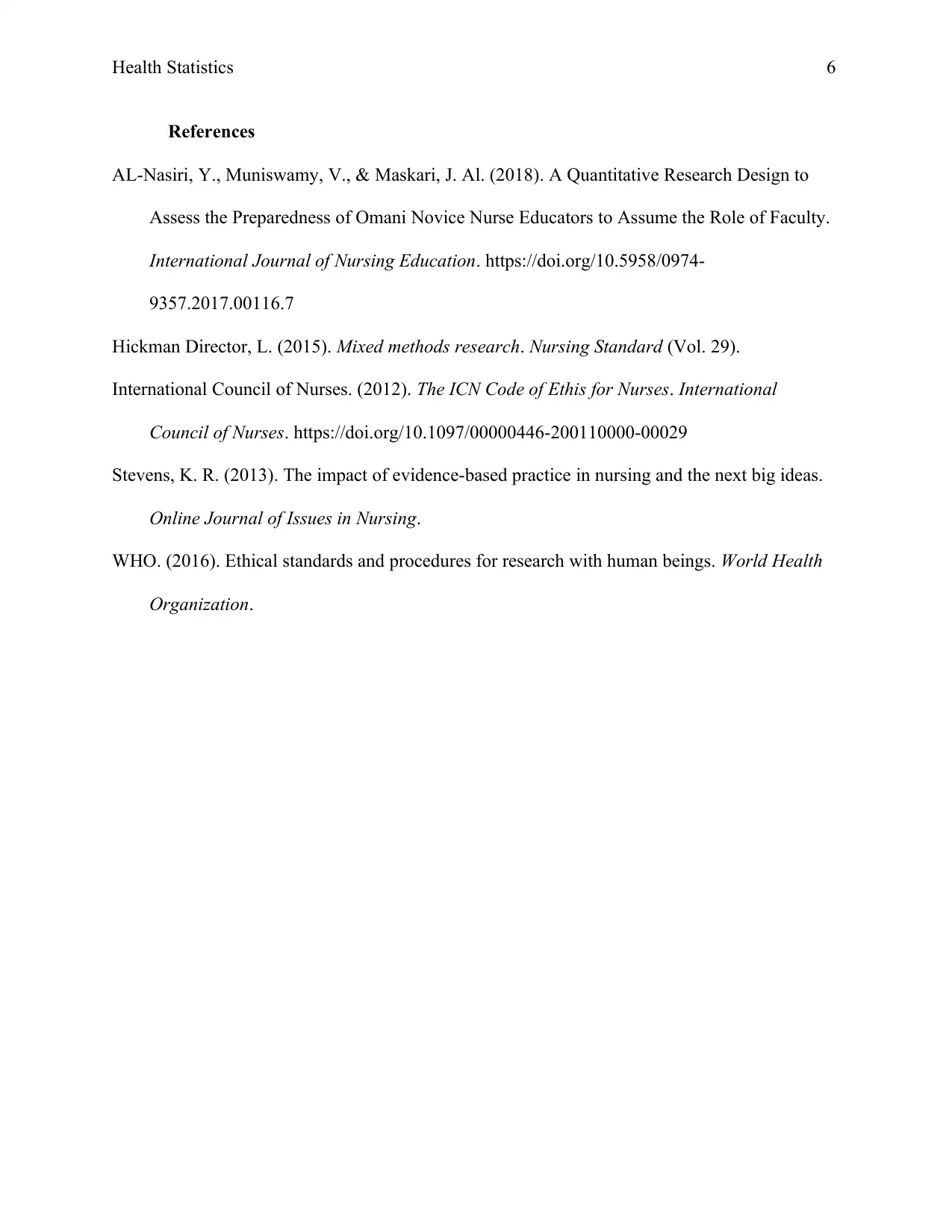
Health Statistics 6
References
AL-Nasiri, Y., Muniswamy, V., & Maskari, J. Al. (2018). A Quantitative Research Design to
Assess the Preparedness of Omani Novice Nurse Educators to Assume the Role of Faculty.
International Journal of Nursing Education. https://doi.org/10.5958/0974-
9357.2017.00116.7
Hickman Director, L. (2015). Mixed methods research. Nursing Standard (Vol. 29).
International Council of Nurses. (2012). The ICN Code of Ethis for Nurses. International
Council of Nurses. https://doi.org/10.1097/00000446-200110000-00029
Stevens, K. R. (2013). The impact of evidence-based practice in nursing and the next big ideas.
Online Journal of Issues in Nursing.
WHO. (2016). Ethical standards and procedures for research with human beings. World Health
Organization.
References
AL-Nasiri, Y., Muniswamy, V., & Maskari, J. Al. (2018). A Quantitative Research Design to
Assess the Preparedness of Omani Novice Nurse Educators to Assume the Role of Faculty.
International Journal of Nursing Education. https://doi.org/10.5958/0974-
9357.2017.00116.7
Hickman Director, L. (2015). Mixed methods research. Nursing Standard (Vol. 29).
International Council of Nurses. (2012). The ICN Code of Ethis for Nurses. International
Council of Nurses. https://doi.org/10.1097/00000446-200110000-00029
Stevens, K. R. (2013). The impact of evidence-based practice in nursing and the next big ideas.
Online Journal of Issues in Nursing.
WHO. (2016). Ethical standards and procedures for research with human beings. World Health
Organization.
⊘ This is a preview!⊘
Do you want full access?
Subscribe today to unlock all pages.

Trusted by 1+ million students worldwide
1 out of 6
Related Documents
Your All-in-One AI-Powered Toolkit for Academic Success.
+13062052269
info@desklib.com
Available 24*7 on WhatsApp / Email
![[object Object]](/_next/static/media/star-bottom.7253800d.svg)
Unlock your academic potential
Copyright © 2020–2025 A2Z Services. All Rights Reserved. Developed and managed by ZUCOL.





